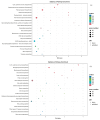A Transcriptomic Study on the Toxic Effects of Iodide (I-) Wet Deposition on Pepper (Capsicum annuum) Leaves
- PMID: 40699712
- PMCID: PMC12109773
- DOI: 10.3390/cimb47050313
A Transcriptomic Study on the Toxic Effects of Iodide (I-) Wet Deposition on Pepper (Capsicum annuum) Leaves
Abstract
Radioactive iodine (129I), released into the environment from human nuclear activities, poses significant health risks to the biosphere due to its long half-life and mobility. This study investigates the toxic effects of wet-deposited iodine on the growth of chili pepper seedlings (Capsicum annuum L.) under soil cultivation conditions. Using sodium iodide (NaI) as the exposure agent, transcriptomic analysis was conducted to evaluate the molecular responses of chili pepper leaves to iodine at concentrations of 2, 4, and 8 ppm. The study identified 2440 and 1543 differentially expressed genes (DEGs) in leaves exposed to 2 ppm vs. 4 ppm iodine and 2 ppm vs. 8 ppm iodine, respectively. GO enrichment analysis showed that DEGs at 4 ppm were significantly associated with protein-chromophore linkage, extracellular region, and iron ion binding, while those at 8 ppm were enriched in defense response, cell wall components, and iron ion binding. Iodine stress disrupted key pathways associated with photosynthesis, antioxidant defense, and cuticle biosynthesis. In particular, the downregulation of key genes related to protein-chromophore binding, lipid metabolism, and cell wall organization indicated reduced photosynthetic efficiency and weakened stress resistance. This study provides molecular-level insights into the ecological risks of iodine stress in plants and offers a scientific basis for managing iodine contamination and breeding iodine-tolerant chili pepper cultivars.
Keywords: Capsicum annuum L.; differential gene expression; functional enrichment analysis; toxic effects; transcriptomics; wet-deposited iodine.
Conflict of interest statement
The authors declare no conflict of interest.
Figures









Similar articles
-
Jasmonic acid-mediated cell wall biosynthesis pathway involved in pepper (Capsicum annuum) defense response to Ralstonia solanacearum.BMC Plant Biol. 2025 Jul 2;25(1):804. doi: 10.1186/s12870-025-06784-4. BMC Plant Biol. 2025. PMID: 40604413 Free PMC article.
-
Identification of inheritance and genetic loci responsible for wrinkled fruit surface phenotype in chili pepper (Capsicum annuum) by quantitative trait locus analysis.Mol Breed. 2024 Dec 26;45(1):5. doi: 10.1007/s11032-024-01528-y. eCollection 2025 Jan. Mol Breed. 2024. PMID: 39734933
-
Efficacy of Hot Capsicum annuum Extracts Against the Biological Activity of Culex pipiens and Musca domestica Larvae with their Phytochemical Profiles.Acta Parasitol. 2025 Jun 9;70(3):129. doi: 10.1007/s11686-025-01066-3. Acta Parasitol. 2025. PMID: 40488911
-
Measures implemented in the school setting to contain the COVID-19 pandemic.Cochrane Database Syst Rev. 2022 Jan 17;1(1):CD015029. doi: 10.1002/14651858.CD015029. Cochrane Database Syst Rev. 2022. Update in: Cochrane Database Syst Rev. 2024 May 2;5:CD015029. doi: 10.1002/14651858.CD015029.pub2. PMID: 35037252 Free PMC article. Updated.
-
Topical pharmacologic interventions versus placebo for epidemic keratoconjunctivitis.Cochrane Database Syst Rev. 2022 Mar 3;3(3):CD013520. doi: 10.1002/14651858.CD013520.pub2. Cochrane Database Syst Rev. 2022. PMID: 35238405 Free PMC article.
References
-
- Riley B.J., Vienna J.D., Strachan D.M., McCloy J.S., Jerden J.L. Materials and Processes for the Effective Capture and Immobilization of Radioiodine: A Review. J. Nucl. Mater. 2016;470:307–326. doi: 10.1016/j.jnucmat.2015.11.038. - DOI
-
- Nandanwar S.U., Coldsnow K., Utgikar V., Sabharwall P., Eric Aston D. Capture of Harmful Radioactive Contaminants from Off-Gas Stream Using Porous Solid Sorbents for Clean Environment—A Review. Chem. Eng. J. 2016;306:369–381. doi: 10.1016/j.cej.2016.07.073. - DOI
-
- Zhao C.-X., Liu J.-N., Li B.-Q., Ren D., Chen X., Yu J., Zhang Q. Multiscale Construction of Bifunctional Electrocatalysts for Long-Lifespan Rechargeable Zinc–Air Batteries. Adv. Funct. Mater. 2020;30:2003619. doi: 10.1002/adfm.202003619. - DOI
Grants and funding
LinkOut - more resources
Full Text Sources

